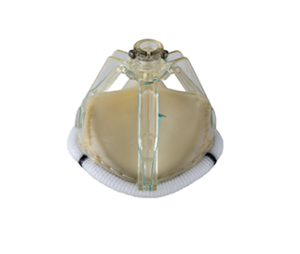
The new St. Jude Medical™ Trifecta™ valve with Glide™ Technology (GT) features several enhancements that make the device easier to implant in patients with challenging anatomies, such as those with a small aortic root, compared with earlier generation of the Trifecta™ valve. Cardiovascular News reviews these enhancements and the data available for the valve.
Michael Borger (Director, Cardiovascular Institute; Director, Aortic Surgery, Columbia University Medical Center, New York, NY, USA), who has used the Trifecta™ valve with Glide™ Technology (GT) in several cases, comments that a key change with this next-generation valve is that the sewing cuff is soft and “more malleable.” He comments: “The sewing cuff now more easily conforms to the patient’s annulus. But importantly, from a surgeon’s perspective, passing your sutures through the cuff is now easier because the needle glides through; facilitating the surgical implant.”
Another “really nice modification” with the Trifecta™ GT valve, according to Borger, is that the foot of the holder is now positioned in the middle of the sewing cuff rather than directly behind the stents. In addition, is the holder is streamlined for better access and visibility.
“With the previous Trifecta™ valve, surgeons had to tie the sutures behind the stent. By changing the position of the attachment point of the holder, the surgeon has much better access to this area when tying sutures. This enhancement certainly eases the implantation process,” he explains.
Additionally, with the Trifecta GT valve, the surgeon only has to cut one suture in the holder. Summing up the enhancements, Borger says that they make surgical aortic valve replacement with the Trifecta GT valve “an easier operation for the surgeon to do”, noting that “anything in cardiac surgery that simplifies the procedure will always be welcome from the surgeon’s point of view”.
Key modifications with Trifecta GT Valve

- Soft compliant sewing cuff with minimal needle penetration, suture drag and parachuting forces for smooth valve delivery.1
- Additional cuff scallop follows the contour of the annulus.2
- Suture markers aid in optimal needle placement and spacing.
- Streamlined conical valve holder for better access and visibility.
- Single-cut, quick-release holder provides greater efficiency.
- Increased radiopacity for future valve considerations.3,4
Borger believes that these modifications may mean that the Trifecta GT valve is easier to implant in patients with complex anatomies than the Trifecta™ valve. He states that, in particular, the lower profile of the device may be of benefit for patients with a small aortic root. “The Trifecta™ valve holder tended to be a bit bulky, which meant you were fighting for space during implantation and securing of sutures in patients with small aortic roots. Again, anything that aids implantation in the operating room is beneficial,” he explains.
He adds that patients who require a total root replacement may also benefit from the valve modifications, commenting that today, more surgeons are performing total aortic root replacement with custom-made “Bio-Roots”. In such a procedure, the surgeon places a stented tissue valve within a Dacron™ graft, sutures the valve and the graft together, and this is then used to replace the aortic root. Borger says that the more malleable sewing cuff of the Trifecta GT valve has made this process easier. “The cuff of the original Trifecta valve was stiffer, so at times capturing the cuff through the wall of the graft was more difficult than it is now with the Trifecta GT valve.”
Evidence base
The improvements to the Trifecta™ GT valve were built upon the original Trifecta™ valve —meaning patients can still benefit from its best-in-class hemodynamic results.5
In the largest prospective evaluations “ever performed” on any surgical aortic valve prosthesis, Bavaria et al.6 reviewed data for 1,014 patients who underwent surgical aortic valve replacement with the Trifecta valve at multiple centres across the globe between 2007 and 2011. They found that at the two-year follow-up point, 83.5% of patients were in New York Heart Association (NYHA) Class I with no patients in NYHA Class IV and 96.1% of patients free from NYHA Class III or IV symptoms. “At one year follow-up, average mean gradients ranged from 10.7 mmHg to 4.7 mmHg and average peak gradients ranged from 19.9 mmHg to 9.2 mmHg for valve sizes 19 mm to 29 mm, respectively,” the authors report. They add that the average effective orifice area ranged from 1.41 cm2 to 2.35 cm2 at one year for valve sizes 19 mm to 29 mm, respectively.
Concluding, Bavaria et al. comment: “The St. Jude Medical™ Trifecta™ valve is a unique pericardial bioprosthesis with design elements that incorporate significant improvements in haemodynamic performance over previous-generation valve while providing ease of implantation.”
Additionally, in a study of the three-year haemodynamic performance of the valve, Ruggieri et al.7 found that the Trifecta valve “retains its excellent haemodynamic properties at the three-year follow-up. The rate of permanent pacemaker implantation is considerably low.”
The role of surgical valves in the era of TAVI
As well as now being used for valve-in-valve procedures, TAVI (initially designed as a treatment option for inoperable patients) is now increasingly being used for lower risk patients. However, Borger believes surgical aortic valve replacement still has an important role to play as there are a number of barriers to using TAVI in lower-risk patients; for example, the increased rates of paravalvular leak and new permanent pacemaker implantation rates seen with some TAVI devices compared with surgery.7 While noting that these rates “are getting better” with the newer TAVI devices, he says that they are still higher than those for surgery and this may have particular implications for younger patients (who are more likely to be lower risk) and comments “living with a pacemaker at age 25 has different implications than living with one at 85 years.”
He adds: “A bicuspid aortic valve is still considered to be a relative contraindication for TAVI. If you look at patients who are low-risk, which predominantly means that they are younger, the majority of them have bicuspid aortic valves. Patients with bicuspid aortic valves who undergo TAVI are known to have a higher risk of paravalvular leak and pacemaker implantation.9 Therefore, for the foreseeable future, surgical aortic valve replacement is definitely going to be the standard of care for that patient group.”
Celebrating 40 years of firsts and innovation
The launch of Trifecta GT valve in the USA (May 2016) comes in the same year that St. Jude Medical is marking 40 years of providing advanced technology for patients. Speaking about the anniversary and the launch of the Trifecta GT valve, the company’s chief medical officer and vice president of global medical affairs Mark Carlson said: “Founded as a pioneering manufacturer of implantable bi-leaflet mechanical heart valves, St. Jude Medical has dedicated significant resources to develop best-in-class heart valve replacement options while refining our devices based on physician feedback and clinical outcomes. The Trifecta GT tissue valve is a true testament of our commitment to the cardiac surgery community and the patients they treat by improving the ability to implant the valve when encountering challenging anatomies and during minimally invasive surgical approaches.”
References
- Jude Medical. Data on File. Technical Report, 90166169.
- Trifecta™ Valve with Glide™ Technology, Instructions for Use, St. Jude Medical, Inc. ARTMT100131328.
- Jude Medical. Data on File. Technical Report, 90203447.
- Bapat, V., Mydin, I., Chadalavada, S., Tehrani, H., Attia, R., & Thomas, M. (2012). A guide to fluoroscopic identification and design of bioprosthetic valves: A reference for valve-in-valve procedure. Catheterization and Cardiovascular Interventions, 81(5), 853-861. doi:10.1002/ccd.24419
- Jude Medical. (2016, May 16). St. Jude Medical Furthers the Company’s Legacy of Heart Valve Excellence With US Launch of the Trifecta Surgical Valve With Glide Technology [Press release]. Retrieved November 22, 2016.
- Bavaria, J. E., Desai, N. D., Cheung, A., Petracek, M. R., Groh, M. A., Borger, M. A., & Schaff, H. V. (2014). The St Jude Medical Trifecta aortic pericardial valve: results from a global, multicenter, prospective clinical study.The Journal of thoracic and cardiovascular surgery, 147(2), 590-597.
- Ruggieri, V. G., Anselmi, A., Chabanne, C., Lelong, B., Flecher, E., Verhoye, J. P., & Leguerrier, A. (2016). Three-year haemodynamic performance of the St Jude Trifecta bioprosthesis.European Journal of Cardio-Thoracic Surgery, 49(3), 972-977.
- Adams et al. (2014, May 8). Transcatheter aortic-valve replacement with a self-expanding prosthesis. New England Journal of Medicine, 371(10), 967-968. doi:10.1056/nejmc1408396
- Indraratna et al. (2016, December 1). Transcatheter aortic valve implantation versus surgical aortic valve replacement: A meta-analysis of randomized controlled trials. International Journal of Cardiology, 224, 382-387. doi:10.1016/j.ijcard.2016.09.018
Rx Only
Brief Summary: Prior to using these devices, please review the Instructions for Use for a complete listing of indications, contraindications, warnings, precautions, potential adverse events and directions for use. These materials are not intended to replace your doctor’s advice or information. For any questions or concerns you may have regarding the medical procedures, devices and/ or your personal health, please discuss these with your physician.
Dacron is a trademark of Invista North America S.A.R.L.
Unless otherwise noted, ™ indicates that the name is a trademark of, or licensed to, St. Jude Medical or one of its subsidiaries.
- JUDE MEDICAL and the nine-squares symbol are trademarks and service marks of St. Jude Medical, Inc. and its related companies.
© 2016 St. Jude Medical, Inc. All Rights Reserved.
SJM-TRF-0916-0106 | Item approved for global use.












